Contact Details: Scotch Macaskill, Dirt Road Traders, Currys Post Road, Howick, KwaZulu-Natal, South Africa. Tel: +27 (0)82 578 2329. Privacy: Your privacy is guaranteed. See our Privacy Policy for more. This site accepts advertising and other forms of compensation - see Disclosure and Advertising for details. Site updated: 2022. Copyright © 2002 - 2022 Scotch Macaskill

| ||||||||||
|
||||||||||
|
SEE ALL |
Taking Wide Angle Bird Photos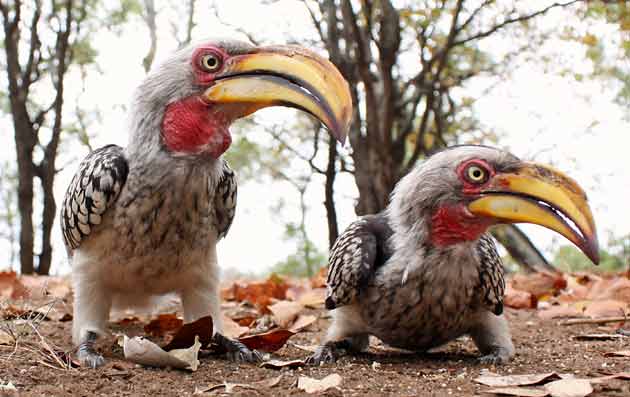 Pair of Yellowbilled Hornbills (Tockus flavirostris) using wide angle lens, Letaba Camp, Kruger National Park, South Africa
Pair of Yellowbilled Hornbills (Tockus flavirostris) using wide angle lens, Letaba Camp, Kruger National Park, South AfricaThe birds are pretty tame around the camps in South Africa's Kruger National Park. Huts and bungalows in the camps usually have comfortable verandahs, ideal for outdoor meals ... and ideal for the birds that hop about, picking up scraps and crumbs. The birds have learnt that visitors to the park are animal-friendly, so they're pretty relaxed around people. Visitors, in turn, enjoy the birds, so encourage them further by feeding them. The tree squirrels have also cottoned on to this source of free food, so also come scurrying across when crumbs are tossed their way. While a variety of birds tend to fly in when they realise there's food around, the glossy starlings are usually at the forefront, bolder and more agressive than the smaller varieties. 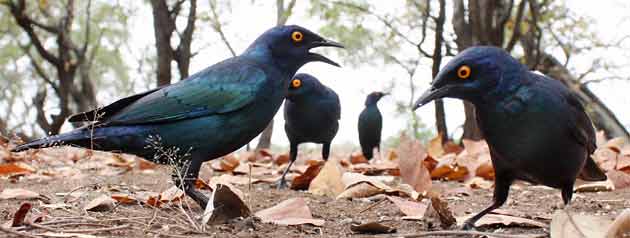 Group of glossy starlings (Lamprotornis nitrens), wide angle view, Letaba Camp, Kruger National Park
Group of glossy starlings (Lamprotornis nitrens), wide angle view, Letaba Camp, Kruger National ParkBut you do also get the big guys -- Natal spurfowl (francolin), helmeted guinea fowl and hornbills -- which is a bonus as one's not likely to see them in a small urban garden, certainly in my part of the world. It's tempting to sit on the verandah, taking shots of the birds on the ground, but the angle's not good as you're shooting downwards. On a previous visit to Kruger I experimented by placing my camera on the ground and firing with a remote shutter-release cable. This was partially successful, but you're still tethered to the camera by a 2ft-long cable, so it's not ideal. Before we visited Kruger this year, I bought myself a
Hahnel Wireless Shutter Release
I only had the chance to try it once, while we were staying at Letaba Camp. Our big bungalow overlooked an expanse of open ground that dropped away to a row of trees. It was an overcast day with a dull, leaden sky as background, but also no contrasty shadows. After finding a suitable area, covered in autumn leaves with no intrusive buildings, I tossed some crumbs around, more in hope than conviction. I'd sort of lost interest when, a while later, my friend Kevin called out that a couple of spurfowl had found the food. I quickly put my camera - a Canon 450D plus18-55mm kit lens -- on the spot I'd previously picked out, making sure the camera was fairly level, with lens focal length set to 18mm. I added more crumbs then backed off a few meters behind a tree from where I could watch proceedings without being intrusive.
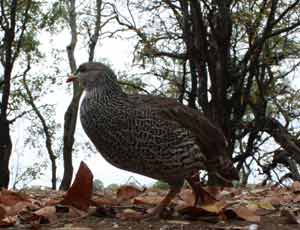
The spurfowl were back in a flash and as a couple of them pecked around, I fired off a few shots using the wireless remote. In my haste to set up the camera, I'd forgotten to think about exposure, leaving it set on AV (aperture priority) at f/8. The sky in the background was influencing the meter, leaving my subjects dark and under-exposed (right). I switched to full manual exposure and took a reading off the ground, similar to mid-gray, giving me an exposure of 1/120 at f/8, ISO 400.
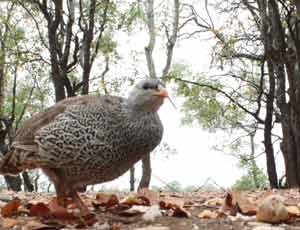
This worked out much better, although there was now a focus problem. The camera was on autofocus with the central focusing spot selected - so anything off center and the camera focused on trees in the background (left). Another adjustment, selecting all focus points, and I was good to go. Some starlings had followed the spurfowl and they now occupied center stage, so I was able to take a couple of shots of them before a yellowbilled hornbill glided in, followed by its partner. This was perfect, as these birds are very photogenic with their distinctive yellow bills, yellow eyes and red facial markings (below). 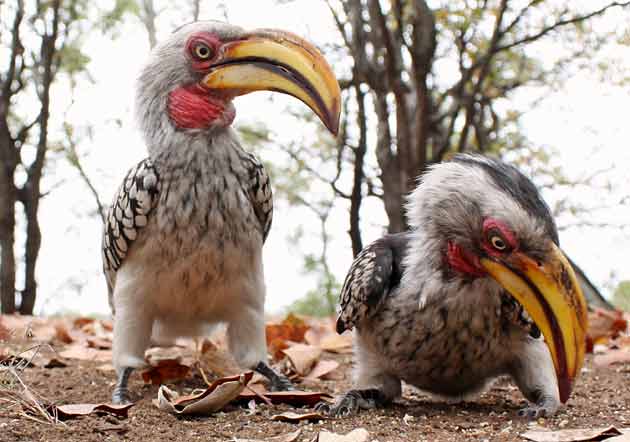 Pair of Yellowbilled Hornbills using wide angle lens with low camera angle, Letaba Camp, Kruger National Park
Pair of Yellowbilled Hornbills using wide angle lens with low camera angle, Letaba Camp, Kruger National ParkThe hornbills were extremely obliging, so much so that they occasionally moved too close to the camera. One of them even took a peck at the lens, probably seeing its reflection. But overall I was able to get some unusual shots, with the wide angle lens exaggerating the bills to sometimes ridiculous proportions (below). 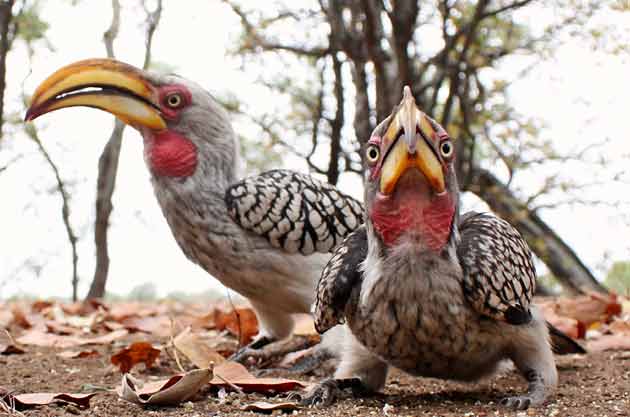 Pair of Yellowbilled Hornbills, their large bills made even more prominent by use of wide angle lens
Pair of Yellowbilled Hornbills, their large bills made even more prominent by use of wide angle lensI also got a squirrel shot (below), so was happy with the experiment. 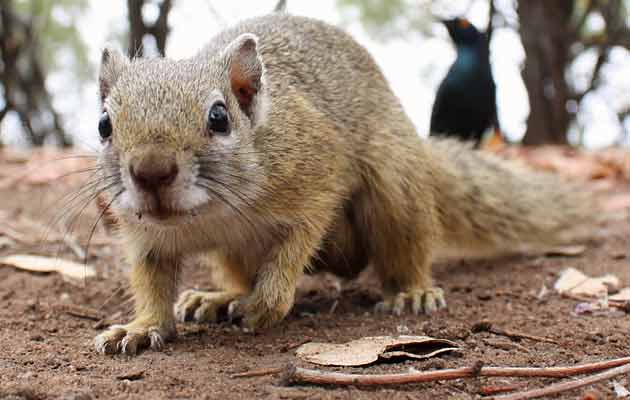 Tree Squirrel (Paraxerus cepapi), wide angle view, Letaba Camp, Kruger National Park, South Africa
Tree Squirrel (Paraxerus cepapi), wide angle view, Letaba Camp, Kruger National Park, South AfricaAlthough some of the pictures are a bit messy in composition, the majority are sharp (as in spurfowl photo below) and definitely a pat on the back for Canon's little plastic 18-55mm kit lens. 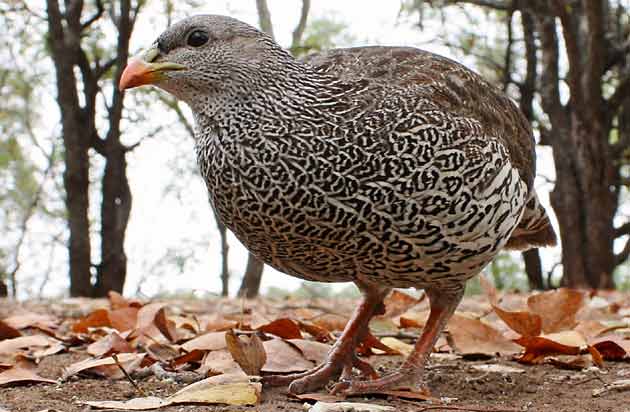 Natal Spurfowl (Pternistis natalensis), wide angle view, Letaba Camp, Kruger National Park, South Africa
Natal Spurfowl (Pternistis natalensis), wide angle view, Letaba Camp, Kruger National Park, South AfricaNext year I hope to be living in the countryside and look forward to capturing more wide angle bird pictures using the
Hahnel Wireless Release
Copyright © Scotch Macaskill. Return to Photo Info page for more photography articles. |
|||||||||
|
|
||||||||||